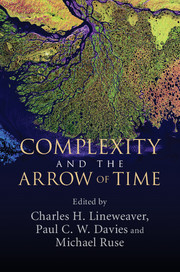Book contents
- Frontmatter
- Contents
- Author biographies
- Part I Introduction
- Part II Cosmological and physical perspectives
- Part III Biological complexity, evolution, and information
- 7 Life: the final frontier for complexity?
- 8 Evolution beyond Newton, Darwin, and entailing law: the origin of complexity in the evolving biosphere
- 9 Emergent order in processes: the interplay of complexity, robustness, correlation, and hierarchy in the biosphere
- 10 The inferential evolution of biological complexity: forgetting nature by learning to nurture
- 11 Information width: a way for the second law to increase complexity
- Part IV Philosophical perspectives
- Index
- References
8 - Evolution beyond Newton, Darwin, and entailing law: the origin of complexity in the evolving biosphere
from Part III - Biological complexity, evolution, and information
Published online by Cambridge University Press: 05 July 2013
- Frontmatter
- Contents
- Author biographies
- Part I Introduction
- Part II Cosmological and physical perspectives
- Part III Biological complexity, evolution, and information
- 7 Life: the final frontier for complexity?
- 8 Evolution beyond Newton, Darwin, and entailing law: the origin of complexity in the evolving biosphere
- 9 Emergent order in processes: the interplay of complexity, robustness, correlation, and hierarchy in the biosphere
- 10 The inferential evolution of biological complexity: forgetting nature by learning to nurture
- 11 Information width: a way for the second law to increase complexity
- Part IV Philosophical perspectives
- Index
- References
Summary
My large aim in this chapter is to take us from our deeply received scientific world view and, derived from it, our view of the “real world” in which we live, that is, from the understanding of the world that was spawned by Newton and modern physics to an entirely different, newly vibrant, surprising, partially unknowable world of becoming in which the living, evolving world, biological, economic, and cultural co-creates, in an often unprestatable mystery, its own possibilities of becoming. If the latter perspective is right, we are beyond Newton, and even beyond Darwin, who, in all his brilliance, did not see that without natural selection “acting” at all to achieve it, the evolving biosphere creates its own future possibilities. And we will see, at the foundations of all this, that no laws entail the evolution of the biosphere, economy, or culture. But the biosphere is the most complex system we know in the universe. If it arose beyond entailing law, we must ask how this can be possible? More, is that “how” a hint to how complexity emerges at least in the living world, and perhaps in the abiotic universe?
We will begin to see ourselves in the living, evolving world in a world of inexplicable and unforeseeable opportunities that emerge with neither the “action” of natural selection in the evolving biosphere, or often without intent in the human world, that we partially co-create. It will follow that we live in not only a world of webs of cause and effect, but webs of opportunities that enable, but do not cause, often in unforeseeable ways, the possibilities of becoming of the biosphere, let alone human life. But, most importantly, I seek in this new world view a re-enchantment of humanity, of which this chapter may be a part. Our disenchantment following from Newton led to modernity.
- Type
- Chapter
- Information
- Complexity and the Arrow of Time , pp. 162 - 190Publisher: Cambridge University PressPrint publication year: 2013
References
- 12
- Cited by



